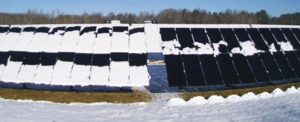
Energy losses due to snow coverage can be high in climates with large annual snowfall. These losses may be reduced with region-specific system design guidelines. One possible factor in snow retention on PV systems could be frame presence and/or shape. Sandia is studying the effect of module frame presence on photovoltaic module snow shedding for a pair of otherwise-identical PV systems in Vermont. The results of this study provide a summary of the findings after the 2018-2019.
See also[edit | edit source]
- Details on PV performance monitoring by R. Andrews. PV Performance Modeling: Assessing Variability, Uncertainty and Sensitivity. Solar Professional Issue 8.5, Sep/Oct 2015.
- "The 10 Snowiest Places on the Planet" by the Mother Nature Network.
- According to Identifying snow in photovoltaic monitoring data for improved snow loss modeling and snow detection - The Marion snow loss model yields more accurate results than purely empirical models. -
- A Review of the Effects of Haze on Solar Photovoltaic Performance
Related Pages[edit | edit source]
- The Impact of Snow Losses on Solar Photovoltaic Systems in North America in the Future
- Snow Losses for Photovoltaic Systems: Validating the Marion and Townsend Models
- Performance of Bifacial Photovoltaic Modules on a Dual-Axis Tracker in a High-Latitude, High-Albedo Environment
- Impact of Snow and Ground Interference on Photovoltaic Electric System Performance
- Image Analysis Method for Quantifying Snow Losses on PV Systems
- Effects of snow on photovoltaic performance
- Open Solar Outdoors Test Field
- Outdoor data acquisition
- Queen's Innovation Park Test Site
- Solar resource measurement for PV applications
- Prediction of energy effects on photovoltaic systems due to snowfall events
- A new method to determine the effects of hydrodynamic surface coatings on the snow shedding effectiveness of solar photovoltaic modules
- Monofacial vs bifacial solar photovoltaic systems in snowy environments





